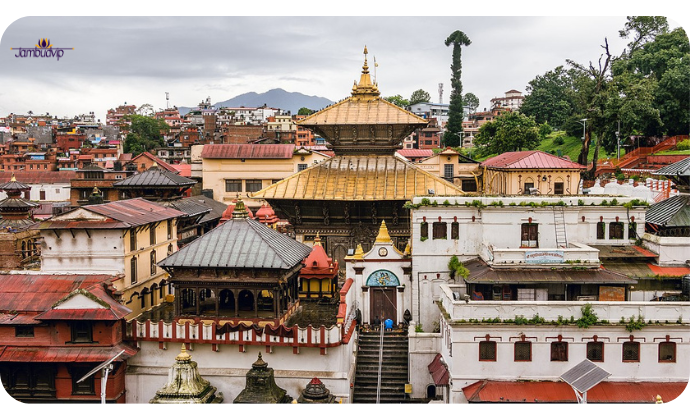Region:- Kathmandu, Nepal.
Main Deity:- Lord Shiva
Avatar Information:- Pashupatinath is an avatar of Shiva, one of the Hindu Trinity. LORD SHIVA is also known as Pashupatinath as he is the God of all animals as well…He protects them equally, loves them cares for them and also saves them from illness, diseases, and untimely deaths…Hence if anyone tortures any animal or disturbs, or hurts them then Lord Shiva punishes them.
Pashupatinath Temple is the oldest Hindu temple in Kathmandu. It is not known for certain when Pashupatinath Temple was built. But according to Nepal Mahatmaya and Himvatkhanda, the deity here gained great fame there as Pashupati. Pashupatinath Temple’s existence is recorded as early as 400 CE.
Temple Built-In:- The Pashupatinath Temple is one of the most sacred temples dedicated to Lord Shiva, located in Kathmandu, Nepal. The exact date of its construction is not known, but it is believed to have been built in the 5th century AD by the Licchavi dynasty rulers of Nepal.
The temple complex covers an area of approximately 246 acres and includes various smaller temples, ashrams, and monuments. The main temple, which is the most prominent structure, is a pagoda-style temple with a two-tiered golden roof and four silver-plated doors. The temple’s inner sanctum houses the lingam, a phallic symbol representing Lord Shiva.
Significance:- The significance of Pashupatinath Temple lies in its cultural, religious, and historical importance. The temple is believed to have been built in the 5th century AD and is considered one of the oldest and holiest temples in Nepal. The temple complex includes many other smaller temples, shrines, and ashrams.
The temple is also the site of the famous Maha Shivaratri festival, which attracts thousands of pilgrims and devotees every year. During this festival, devotees fast and offer prayers to Lord Shiva throughout the night.
Worship Process:- the worship process of the temple involves several rituals and practices. Here is a brief overview of the worship process of Pashupatinath Temple:
- Abhishek: The worship process begins with the Abhishek or the ceremonial bathing of the idol of Lord Shiva. The idol is bathed with milk, honey, water, and other auspicious substances.
- Puja: After the abhishek, the idol is dressed in new clothes, and a puja or a prayer is offered to Lord Shiva. Devotees offer flowers, fruits, and other offerings to the deity.
- Aarti: Aarti is performed several times a day at the temple. During the aarti, the idol is adorned with lights, and devotees offer prayers and sing hymns in praise of Lord Shiva.
- Bells and Conch Shell: The sound of bells and conch shells is considered auspicious in Hinduism. Devotees ring bells and blow conch shells during the worship process to invoke the blessings of Lord Shiva.
- Prasad: Prasad or the blessed food is offered to the deity, and then distributed to the devotees as a symbol of blessings and good luck.
The worship process at Pashupatinath Temple is a beautiful and spiritual experience that attracts devotees from all over the world.
Temple History:- The history of Pashupatinath Temple dates back to ancient times, and the temple has undergone numerous renovations and restorations over the centuries.
According to legends, the temple was originally built by a Lichhavi king named Supuspa in the 3rd century BC. However, the current temple structure was built in the 15th century by the Malla kings of Nepal, who ruled over the Kathmandu Valley during that period. The temple was later renovated and restored by successive rulers, including King Bhupatindra Malla in the 17th century and King Pratap Malla in the 18th century.
The Pashupatinath Temple complex covers an area of 264 hectares and consists of numerous shrines, temples, and ashrams. The main temple is a pagoda-style structure with a gilded rooftop, intricately carved doors, and beautifully decorated interiors. The temple is surrounded by a courtyard, which is lined with smaller temples and shrines dedicated to various deities.
The Pashupatinath Temple is also home to several festivals and rituals, which attract thousands of devotees every year. The most significant festival is the Maha Shivaratri, which is celebrated in February or March and marks the marriage anniversary of Lord Shiva and Goddess Parvati. During this festival, devotees offer prayers and perform rituals throughout the night to seek the blessings of Lord Shiva.
How to Reach:-
By Roadway:
- Pashupatinath Temple is located in the capital city of Nepal, Kathmandu. You can reach Kathmandu by bus or taxi from nearby cities such as Pokhara, Chitwan, or any other city in Nepal. There are also daily bus services from cities in India such as Varanasi, Delhi, and Kolkata to Kathmandu. Once you reach Kathmandu, you can take a taxi or public transport to Pashupatinath Temple.
By Railway:
- Unfortunately, there is no direct railway connectivity to Kathmandu, Nepal. The nearest railway station is Gorakhpur in India, which is about 250 km away from Kathmandu. From Gorakhpur, you can take a taxi or bus to reach Kathmandu. However, the road journey can be time-consuming and may take around 8-10 hours depending on traffic and road conditions.
By Airway:
- The easiest and fastest way to reach Pashupatinath Temple is by airway. The nearest airport is Tribhuvan International Airport in Kathmandu, which is well-connected to major cities in India, Southeast Asia, and other international destinations. Once you reach Kathmandu airport, you can take a taxi or public transport to reach Pashupatinath Temple, which is only a 10-15 minute drive from the airport.
Timings to visit Pashupatinath Temple:-
The inner temple area is open daily from 4 AM to 9 PM.
Devotees can visit the lingam from 5 AM to 12 PM as well as from 5 PM to 7 PM.
Timing of Abhishekam: 9 AM to 11 AM.



Leave a Reply